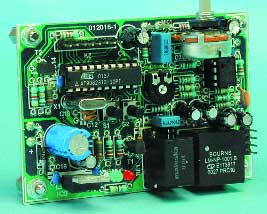Telephone Baby Monitor
cut through the static

This is a MEMBER ONLY article. You need a subscription to read this article.
- Access to Elektor archive and 5,000+ Gerber files
- Receive up to 8 magazines per year (digital and/or paper)
- 10% discount in the Elektor store
Available from €4.95 per month.
What is Members Only
Elektor is committed to providing high-quality content on electronics, catering to tens of thousands of paying members. As part of this commitment, Elektor has launched Premium, an initiative that offers exclusive online articles to members sometimes even before they appear in the magazine.
Every day, members can access in-depth articles that showcase the best of Elektor's premium content.
This initiative aims to reward members with early access. Once logged in, members can easily enjoy this exclusive content and engage in discussions about featured projects. While Premium adds to the existing resources available, Elektor will continue to provide a wealth of free information.
Join the Elektor community today to take advantage of Premium and other benefits!
Materials
Gerber file
CAM/CAD data for the PCB referred to in this article is available as a Gerber file. Elektor GREEN and GOLD members can exclusively download these files for free as part of their membership. Gerber files allow a PCB to be produced on an appropriate device available locally, or through an online PCB manufacturing service.
Elektor recommends the Elektor PCB Service service from its business partner Eurocircuits or AISLER as the best services for its own prototypes and volume production.
The use of our Gerber files is provided under a modified Creative Commons license. Creative Commons offers authors, scientists, educators and other creatives the freedom to handle their copyright in a more free way without losing their ownership.
Extra info / Update
Component list
R1,R4 = 10k?
R2 = 8k?2
R3 = 2k?2
R5 = 100?
R6 = 220k?
R7,R24 = 47?
R8,R10 = 1k?5
R9,R13,R14 = 100k?
R11 = 15k?
R12,R22 = 33k?
R15 = 1k?
R16 = 560?
R17,R18 = 220?
R19,R20 = 4k?7
R21 = 47k?
R23 = 180k?
P1 = 10k? preset H
P2 = 22k? potentiometer, linear, mono, miniature version
Capacitors:
C1 = 680nF
C2 = 68pF
C3 = 47µF 25V radial
C4 = 220µF 10V radial
C5,C6,C10 = 1µF 63V radial
C7,C14,C15,C16,C18 = 100nF ceramic
C8 = 470pF
C9,C17 = 10µF 63V radial
C11 = 470nF
C12,C13 = 22pF
C19 = 470µF 25V radial
Semiconductors:
D1 = LED, red, 3mm
D2 = LED, green, 3mm
D3 = 1N4148
D4 = zener diode 12V 1.3W
D5 = 1N4002
T1 = BC547B
T2 = BC557B
IC1 = AT90S2313-10PC, programmed, order code 012016-41
IC2 = TS922IN (Farnell)
IC3 = 7805
Miscellaneous:
K1 = 4-ay SIL header
K2 = 8-way SIL header
S1,S2 = pushbutton, 6x6 mm
Re1 = subminiature relay 16x119x11.5 mm with SPDT contact, e.g., Maluska FRS1B-S DC 5V, (5 V, 56 ?, Conrad Electronics # 505188)
X1 = 10MHz quartz crystal (Cload = 32pF, parallel resonance)
Tr1 = line transformer, Bourns LMNP-1001 B)
MIC1 = electret Microphone element (e.g., Monacor/Monarch MCE2000)
PCB, order code 012016-1
Disk, C source code and hex files, order code 012016-11



Discussion (0 comments)